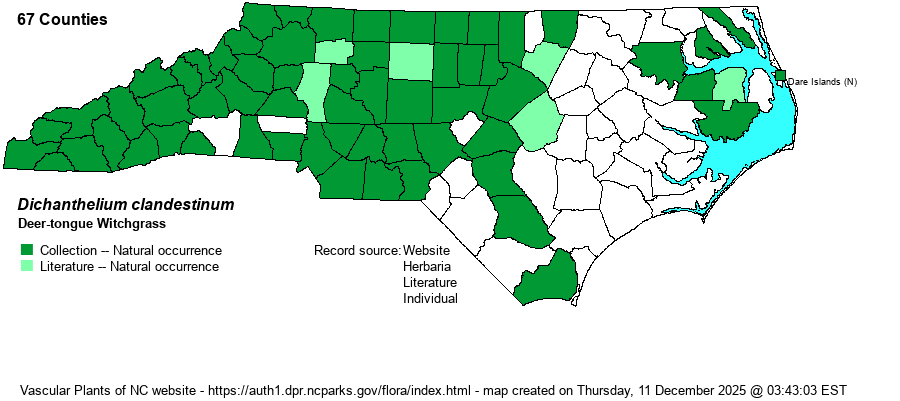| Author | (L.) Gould | |
| Distribution | Mountains and Piedmont; Coastal Plain along the Cape Fear River and in the northeastern part of the state.
N.S. and Que to IA, south to northern FL, KS, and TX. | |
| Abundance | Common in the Mountains and Piedmont; uncommon to infrequent in the Coastal Plain, mostly in the northeast, but also extending down the Cape Fear River to Brunswick County. This is clearly an S5 species, not S4 as ranked by the NCNHP. | |
| Habitat | Floodplain forests and bottomlands of brownwater river systems, occurring well upstream along tributaries and on gravel bars, sand bars, and rock cobbles. Rather weedy on moist roadsides, clearings, ditches. |
| Phenology | Flowering and fruiting May-October. | |
| Identification | This robust Dich is easy to identify, with its often overlapping leaf sheaths (thus, parts of the stem are not visible) and stiff hairs on the sheaths. The vernal inflorescence is visible, but autumnal ones are hidden within the leaf sheaths. These plants are clonal via thick rhizomes. | |
| Taxonomic Comments | None, other than being included within Panicum in older references.
A note about Dichanthelium: This genus is not impossible to identify to species! But it takes applied effort over a period of time in order to learn the various species and what their morphological limits are. We strongly recommend that you read the introduction to the treatment in Weakley et al. (2023), written by Richard LeBlond. LeBlond has made order out of near chaos, and his keys work very well for our plants. Most Dichanthelium taxa ("Dichs") do not grow everywhere indiscrimminately, but prefer certain well-defined habitats. Note that most species produce flowers/fruits twice a year -- a vernal period and an autumnal period -- and that measurements of spikelets and achenes are taken from vernal plants. Some species also have a third, or summer, period. In the vernal period there is a single inflorescence at the tip of the stem. In the autumnal period, plants produce elongate branches with bunched (congested) leaves and so look quite different from vernal plants. Inflorescences are produced in leaf axils as well as at the tips of branches. NOTE: Older texts had these species essentially all within the very large genus Panicum. "Dich" species are typically named as "Witchgrass" and Panicum species named as "Panicgrass". | |
| Other Common Name(s) | Deer-tongue Grass is the usual name, but the website editors prefer to give all Dichanthelium species a group common name of Witchgrass. | |
| State Rank | S4 [S5] | |
| Global Rank | G5? [G5] | |
| State Status | | |
| US Status | | |
| USACE-agcp | FACW link |
| USACE-emp | FAC link |

